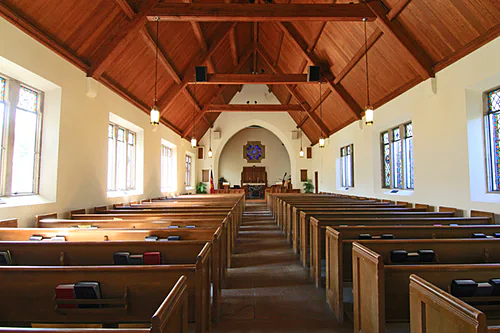Brother Xiao Liu made the choice of becoming a Christian because he had been confused about various big issues to which no satisfying answers could be found, but it was not at all because he has a Christian family. All the troubling questions he had were the “great matters” in the eyes of his classmates because they had neither real-life significance nor practical value. They were the ultimate questions about the world and life.
A source of happiness was found in the interest in philosophy by Brother Liu who is intimate and quiet. When talking with his classmates, he could always get envious eyes for his simple words. This made him acknowledge that thinking was a state of life even though many ideas could not be understood, and even when some questions required more than one answer.
With such a mentality and the many questions, he was enrolled to study a liberal arts major at a university. However, these problems could not be solved by merely studying at a university. Although the materials in the library provided various possible answer resources, he was still puzzled.
It was not until his freshman year when he discovered a church adjacent to his university and the vibrant young people there, that he suddenly realized that maybe his previous questions might have their answers in religion.
After joining the church, he did not intend to become a Christian because figuring out the ultimate questions was not the same as being a religious believer.
But as time went on, he was baptized as a Christian and joined the youth fellowship of the church.
Yet, as he became a true Christian and was accepted by the church, he encountered another problem, that was, many of his questions could not be discussed in the church. For instance, questioning the Bible, different ideas about doctrines, talking about other religions is an especially forbidden topic that would be avoided immediately once it was mentioned.
Xiao Liu soon understood that the current situation in many churches in China is not about discussing the ultimate questions (precisely it is not discussions), rather it is believing, believing in a set of doctrinal beliefs, which can not be changed or challenged because everything else is wrong – anything else would be labeled as heresy.
“Heresy” is a word he hears frequently in his church - as long as the doctrines and ideas are different from that of his own church they are all heretical. Therefore, once you are branded a heretic by the church, it may mean that you will be alienated and isolated. This reminds him of the woman who suffered from bleeding in Jesus’ time.
Liu, a junior, was thinking about a way out of this dilemma when the COVID-19 pandemic suddenly struck. All in-person activities of his church were suspended and online services became the norm. As online gatherings increased, he received messages from other churches one after another. Online services as a technological breakthrough in regard to the onsite gatherings allowed him to access to various church resources.
The suspension of church meetings allowed believers to freely gather onsite or in online meetings. Liu began to find young believers with similar ideas, even believers from other churches. They formed an online gathering group. In this group, they are free to discuss issues. Unless the administrator removes you, you can speak freely. Because this group is made of all lay believers and there is no supervisor of the so-called “orthodox doctrine”, they can discuss freely, in which he regains the joy of discussion and thinking.
Liu’s experience is not an individual case, but an emerging phenomenon. The decline in megachurches caused by the normalization of the COVID-19 pandemic has given active and thinking believers opportunities to group together and think freely without the control of many churches that have turned orthodox doctrine into dogmatism.
What is the significance of this phenomenon? We must understand the concept of the orthodox doctrine and who will control the orthodoxy of doctrine.
The so-called orthodox doctrine, obviously suggested by its literal meaning, is the real continuity. In ancient times, the legitimacy of a successor to the throne depended on whether he had an orthodox position, including bloodline or the will of the last emperor; or whether he conformed to the order and thought of succession to the throne of a dynasty. The orthodox thought of a dynasty was also the ideology recognized by the kingship. For instance, many dynasties in ancient China listed Confucianism as their orthodox school of thought.
Therefore, once a stipulation was listed as orthodox, it meant that it could only be accepted but not questioned or denied. Therefore, orthodoxy is not a multiple-choice question.
Let us see that the establishment of orthodoxy is often not the result of debate and discussion, but more of the result of coercion by power. For example, the establishment of Legalism in the State of Qin (770 B.C. - 207 B.C., one of the former Warring States that ultimately conquered the other six and unified them) was orthodox. Until Emperor Wu of the Han Dynasty (156 B.C. - 87 B.C.), purposive Taoism had been orthodox. After the Emperor, Confucianism began to rise, and then the basic Confucianism was orthodox. In the Tang Dynasty (618 A.D. - 907 A.D.), Taoism began to become orthodox because of the illegality of its regime. So orthodoxy was established but not as a result of natural selection.
At the beginning of Christianity, there was no orthodoxy mentioned in Paul’s letters. Some people belonged to Paul and some belonged to Peter. At this time, before the enlightenment of China, there were a hundred schools of thought contending in Christianity, so we can see the brilliant church fathers and theologians. After Christianity became the national religion, the emperor began to establish orthodoxy, held a grand council, and established orthodoxy by force. Everything that was different from the orthodox doctrine was regarded as heresy and was either suppressed or appeased.
Church orthodoxy is maintained by secular power, that is, secular regime. After the Reformation, Protestantism had no papal state, but it did not mean there was no orthodox doctrine. They still had orthodoxy, and this orthodoxy was maintained by the church. Of course, not the small churches, but the megachurches maintained this. Once a small church was branded as heretical, it would be rejected by the big church. Therefore, in general, small churches should look like big churches.
Then, at present, in Chinese churches, orthodoxy is also easily controlled by megachurches. Because large churches have a great influence among believers, they have the coercive power of public opinion to the small church. Now, the economic downturn caused by the COVID-19 pandemic, the reduction of social activities, and various international backgrounds have led to the reduction of the economic and social space of megachurches thus leading to their corresponding decline.
The decline of big churches means that the maintenance of orthodox doctrine tends to be loose, and small churches are separated from the right to speak held by the big church in orthodox doctrine. The small churches begin to have their own free space.
Similarly, the normalization of the pandemic as well as the international environment not only make big churches decline, but also the whole church community tends to decline, and its influence and control decline with the subsequent decrease of economic income. This allows space for individual believers to freely group together and think. As a matter of fact, more and more active and thoughtful young believers are organizing their own small groups. These groups are different from the hierarchical structure of the church but more inclined to the equal relationship between Jesus and his disciples.
Throughout the history of Christianity, the era of brilliant ideas and culture is mostly in the period of the decline of large churches, the church fathers' dominance, the Augustine era, the Caroline Renaissance, and the 16th century Renaissance, etc. All those eras came into being under the background of the decline of megachurches.
In today’s era, for Chinese Christianity, crisis and opportunity coexist, which is both the worst and the best, because when the new wine is brewing and the new wineskin is being made!
- Translated by Charlie Li












